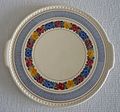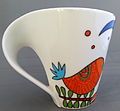Villeroy & Boch
 | |
| Company type | Public (ISIN: DE0007657231) |
|---|---|
| ISIN | DE0007657231 |
| Industry | Ceramics |
| Founded | Lorraine, Holy Roman Empire (1748) |
| Founder | François Boch and Nicolas Villeroy |
| Headquarters | , |
Key people | Frank Göring, Jörg Wahlers, Nicolas Luc Villeroy, Andreas Pfeiffer, Manfred Finger, Volker Pruschke |
| Products | Tableware, bathroom ceramics |
| Revenue | €744 million (2012) €743 million (2011) |
| 96,800,000 Euro (2022) | |
| 71,500,000 Euro (2022) | |
Number of employees | 7400 (2013) 10200 (2008) |
| Divisions | Tableware Bathroom and Wellness |
| Website | www.villeroy-boch.com |
Villeroy & Boch (French pronunciation: [vilʁwa.eˈbɔk], German: [ˌvɪlərɔɪ.ʔʊntˈbɔx]) is a large manufacturer of ceramics[1] with the company headquarters located in Mettlach, Germany.
Company history
The company began in the tiny Lorraine village of Audun le Tiche, where the iron master François Boch set up a pottery company with his three sons in 1748.[2] In 1766 Boch was licensed to build a ceramics kilnworks nearby at Septfontaines, Luxembourg, where it operated a porcelain factory. In 1785 Nicholas Villeroy became sole owner of the faience manufactory at Wallerfangen. In 1812 Jean-François Boch began construction of kilns at the nearby town of Mettlach, Saarland. In 1824 Boch commenced transfer printing on porcelain from engraved copper plates. On 14 April 1836, the Jean François Boch company merged with that of the competitor, Nicolas Villeroy, and became Villeroy & Boch, (V&B, also simply 'VB'). Since 1869, when Villeroy & Boch opened the first manufactory specializing in architectural tiles, the company has operated in three main areas, autonomous until 1982, tablewares, tiles for flooring and revetments, and fine plumbing fixtures.
Among its innovations in Mettlach at the end of the nineteenth century.was Phanolith, a kind of semi-transparent porcelain that combines the characteristics and benefits of jasperware and pate-sur-pate.[3] The creator of the Phanolith was the ceramics artist Jean-Baptiste Stahl, who headed the modelling section of Villeroy & Boch. Phanolith gained first wide public attention at the Paris Exposition Universelle (1900).
Villeroy & Boch has continued to base its broadest market in Germany.
Current situation
The company's Luxembourg factory was closed down in 2010. While the company is no longer run by a family member, under the present Group Chairman Frank Goering, there are various family members presently working in the company. Since 1990 the company has been listed on the German stock market, ticker symbol VIB3, but the voting capital is still in the hands of the family descendants. The majority of V&B shares is owned by Eczacibasi Holding.[4]
- Examples of product range
-
Vase with the decor "Old Luxemburg"
-
Plate to commemorate the Golden Wedding of Eugen von Boch and his wife Oktavie in 1892
-
Tea cup, made in Wallerfangen
-
Vase of Phanolith-stoneware, design and realization Jean-Baptiste Stahl (1869-1932)
-
Phanolith Jardinière: design and realization Jean-Baptiste Stahl (1869-1932)
-
Phanolith wall plate: design and realization Jean-Baptiste Stahl (1869-1932)
-
Boxes for spices from incised stoneware
-
Lion figure made in 1910 by a worker for his son (traditionally, workers made such items for their children)
-
Soap dish, washbowl, and washstand pitcher design "Drina" (beginning of 20th century)
-
Vase design "Adria", c. 1934
-
Cake plate design "Goslar", mid 1930s
-
Milk jug design "Doris", c. 1930
-
Company logo on the bottom of a vase, c. 1934
-
Crystal glass, made in Wadgassen
-
Cup, made in the 2000s
Footnotes
- ^ Packagedfacts.com
- ^ Timeline and brief history notes supplied by Villeroy & Boch AG to FundingUniverse.
- ^ Post, Anton (1976). Ammelounx, Hans (ed.). Mettlacher Steinzeug 1885 - 1905. Saarwellingen: Hans Ammelounx.
- ^ Benmayor, Gila. "http://www.hurriyet.com.tr/yazarlar/23664644.asp".
{{cite news}}: External link in|title=
External links
- Company homepage Villeroy-Boch.com
- Chateau de Septfontaines ... origin of VB factories
- Museum of Ceramics by Villeroy & Boch
- Anna Boch.com, impressionist painter, famous Art Collector - Boch family 4th generation
- Eugene Boch.com, impressionist painter, friend of Vincent van Gogh - Boch family 4th generation
- A history of the Villeroy - Boch porcelain markings
- Mettlach Exhibition at the American Museum of Ceramic Art




![Jar of incised stoneware (designer: de [Heinrich Schlitt]](http://upload.wikimedia.org/wikipedia/commons/thumb/0/05/VundBKrugGeritztesSteinzeug%28Schlitt-Zwerg%29.jpg/68px-VundBKrugGeritztesSteinzeug%28Schlitt-Zwerg%29.jpg)










